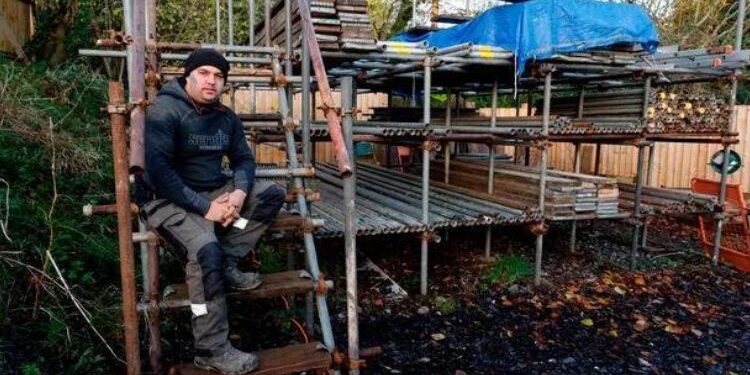In the 1990s, 16-year-old Jamie Fuller killed his 14-year-old girlfriend Amy Carnevale in a violent act of teenage angst and possessiveness. His murder remains a chilling reminder of how destructive infatuation can be.
After serving 26 years behind bars, in 2019 Fuller became eligible for a parole hearing. This pivotal moment marked the beginning of a new phase in his journey, one centered on redemption and change.
Life in Prison
In this episode of ‘Emma Kenny Crime Time,’ we take a deep dive into the story of Jamie Fuller, the 16-year-old boy who murdered his 14-year-old girlfriend. The case is a terrifying reminder that young infatuation can turn into lethal aggression. Fuller’s tale is a twisted web of teenage angst, possessiveness and toxic masculinity.
On August 23, 1991, Fuller lured Amy Carnevale to his home in Beverly, Massachusetts, with promises of a party and a new phone. He was a heavy drinker and had been using bodybuilding steroids. When she questioned him, he became enraged. He then stabbed her multiple times and cut her throat. Her worried friends reported her missing to the police, and suspicion fell on Fuller due to his lack of concern and threats.
The night of her murder, Fuller dragged Carnevale to a wooded area where he stabbed her in the stomach and back and then slit her throat. He stomped on her, and she struggled to get away from him. He boasted to his friends about what he had done and threatened them, telling them that they would be next. He washed the blood off his arms at his friend Sciola’s house and drank red Kool-Aid, saying it was “just right for the occasion.”
Fuller and two of his friends helped him dispose of her body by tying her to cinder blocks and throwing her in Shoe Pond. The group later told the police what they had done.
Fuller was convicted of first-degree murder and sentenced to life in prison. He was released on parole in April 2022, but was arrested again less than a year later. He had violated his parole conditions when he used a moped to transport a girlfriend. Branch County Circuit Judge Bill O’Grady added two to five years consecutive to his previous prison terms. Coldwater police saw him riding the moped and pulled him over when his lights and sirens went on. He then drove between two cars and jumped a curb, flattening a tire. He was arrested and sent back to Three Rivers.
Building a Better Future
The story of Jamie Fuller is a powerful testament to the power of redemption. A life shaped by challenges and missteps led him to encounters with the criminal justice system, which he overcame to emerge from prison as a fundamentally transformed individual. His path to change was paved with advocacy and dedication to reform.
Fuller’s incarceration began with a conviction in 1999 for auto theft in Genesee County and ended when he was caught driving across state lines into Kent County in 2003. He was serving a parole violation sentence for another conviction in Branch County at the time of his murderous attack on Amy Carnevale, who was pregnant with his child.
Friends described Fuller as a jealous and ill-tempered teen who always wanted things his own way. He had been threatening to kill her on-again-off-again girlfriend, but they were unsure whether he would follow through with it. When he finally did, the horror of her gruesome murder was beyond what they had ever imagined.
He was just sixteen at the time of the killing and had been using alcohol and steroids regularly. During his trial, three experts, two psychiatrists and a clinical psychologist, testified about Fuller’s mental state. One of the psychiatrists said he believed that Fuller was suffering from a condition called dysthymia, which is characterized by long term lower level depression.
Following his release from prison, Fuller worked as a coach for Scotland County High School’s girls basketball team. He also worked as a youth mentor, helping children in Portsmouth and elsewhere in Ohio. He now works for Community Bridges in a women’s outpatient program and as a housing specialist.
In addition to his work with Community Bridges, Fuller serves as the coordinator of Leaf, a program that helps young people find hope and healing through art. He also continues to be an advocate for a better world through his advocacy efforts on social justice issues such as sports-related ethics and athlete welfare. He has inspired countless individuals, both inside and outside of the prison walls, and his story remains a shining example that second chances are possible.
Redemption
Jamie Fuller’s story is an enduring testament to the power of redemption and the potential for transformation in spite of adversity. His journey through prison embodies the notion that anyone, no matter their past, can build a better future if they’re determined enough and willing to work hard enough. His advocacy continues to inspire individuals both inside and outside of prison walls, serving as a reminder that the possibilities for change are endless.
Fuller’s ability to communicate complex feelings with such an unflinching directness prefigured the way he tackled troubling social issues in his later films. In The Dark Page, the oedipal story of an experienced newspaper editor and his protégée, an ambitious young reporter, he portrays both men’s ruthlessness and their lingering fervor for truth—an ambivalence that reveals itself when the older man’s jaded ruthlessness finally overtakes him.
Freed from the constraints of central-casting cliches, Fuller’s actors create compelling characters who are both real and believable. He animates them with expressions and textures that he could not achieve through a camera even in his early, more pedestrian works. He also evokes an atmosphere of urban decay that gives each scene its own evocative texture, creating a sense of place.
While the film is set in New York City, Fuller captures the feel of the South Side working class neighborhoods. The shabby buildings, the grimy streetlights, and the hulking dockyards all contribute to the feeling of dislocation that pervades the film. The dark, brooding mood carries the viewer through a series of events that gradually reveal each character’s inner demons.
Throughout his time in prison, Fuller encountered many challenges that tested his resilience and capacity to grow. His perseverance and commitment to his goals became the foundation for the life that he would go on to build after leaving prison. Today, he is sober and an active member of his church in Portsmouth, Ohio. He’s also the father of a healthy and rambunctious son born while he was still in prison.
He now serves as an advocate for prisoners’ rights and teaches others about the value of forgiveness and positive self-development. He’s also an active member of the Let the Truth Be Told Ministries prison ministry, and hopes his story can help inspire others to break the cycle of crime and prison incarceration.
Advocacy
Jamie Fuller is an inspiration to us all, showing that anyone can turn a bad situation into a new opportunity for a better life. He has been able to build a successful career as an advocate, and his story serves as a reminder of the power of redemption.
He was raised in a challenging environment, and he had to deal with a lot of adversity. He took advantage of every opportunity to educate himself, and he committed to change. As he prepared for parole eligibility, he became a model of transformation and hope.
Jaimie Fuller is the founder of an international pressure group called Change Cycling Now, which aims to reform the governance structure and policies of the sport’s governing body, the Union Cycliste Internationale (UCI). The group has gained considerable momentum in recent years thanks to the growing scrutiny of cycling’s doping scandals and the resignation of former UCI president Pat McQuaid in 2012.
While there are differences between advocacy and activism, both are important. Advocacy involves influencing decision makers and demanding change that works for the benefit of humanity. It’s an essential component of democracy, and it can be done in a number of ways.
Among the most popular forms of advocacy are public speaking, educating others about a particular issue, and supporting other people’s causes. Advocacy can also include the use of social media to spread a message and rally support.
In addition to his work with the UCI, Fuller has advised various companies on their communications strategy and helped to develop a number of brands. He has helped a technology firm re-organize its internal communication functions, and he has assisted a financial services company in managing a rebranding effort.
He has also helped a healthcare organization prepare for a brand launch and re-organized its communications function. He has also worked with a global consulting firm and was part of the management team that advised a consumer product company during its initial public offering (IPO). He has also managed numerous crisis communications programs and has been involved in the planning, development, and execution of numerous major public policy initiatives.












